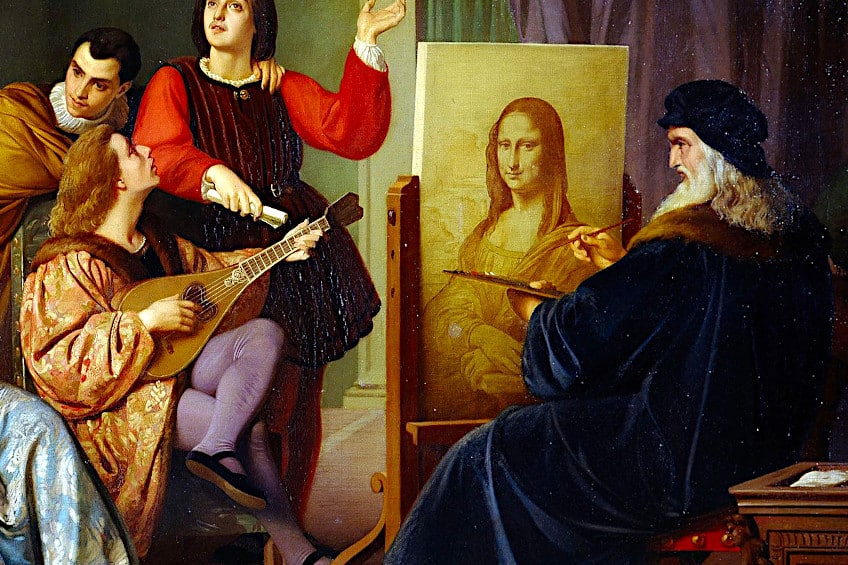“Mona Lisa” by Leonardo da Vinci – Get to Know La Giaconda
Why is the Mona Lisa so famous, and who was Mona Lisa, the enigmatic woman featured in this famous artwork? The Mona Lisa by Leonardo da Vinci is without a doubt one of the most recognizable artworks ever created. Said to be the portrait of Lisa Del Giocondo, it was unique for its time due to the female subject’s pose and direct gaze at the viewer. Let’s explore the facts about Mona Lisa, and address your questions, such as, “how much is the Mona Lisa worth today”, “where is the Mona Lisa painting currently housed”, and “who painted the Mona Lisa?”
The Story of the Mona Lisa by Leonardo da Vinci
| Artist | Leonardo di ser Piero da Vinci (1452 – 1519) |
| Production Period | c. 1503 – c. 1517 |
| Medium | Oil on poplar panel |
| Dimensions (cm) | 77 x 53 |
| Current Location | The Louvre Museum, Paris, France |
When was the Mona Lisa painted? There are no definitive dates regarding exactly when Da Vinci produced this famous masterpiece, although it is generally believed that he started at some point between 1503 and 1506, and perhaps continued working on it until around 1517.
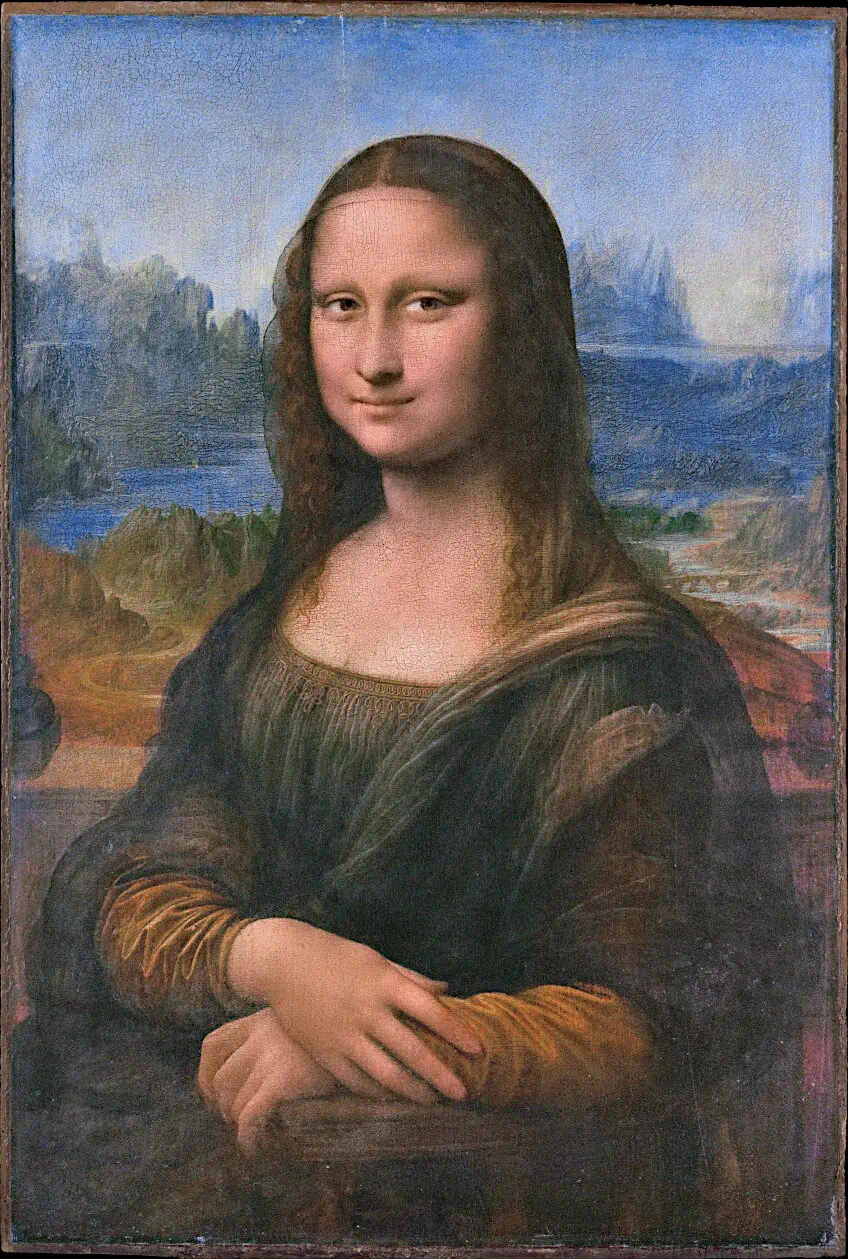
Most people already know who painted the Mona Lisa, as Da Vinci is just as well-known (if not more) as the painting he created. However, before we learn any more about the Mona Lisa painting, let’s briefly discuss the artist behind the work.
A Brief Introduction to Leonardo da Vinci
| Name | Leonardo di ser Piero da Vinci |
| Nationality | Italian |
| Date of Birth | 15 April 1452 |
| Date of Death | 2 May 1519 |
| Place of Birth | Vinci, Republic of Florence, Italy |
There is no doubt that Da Vinci is one of the most celebrated individuals in human history – not just in art circles, but across the fields of science, architecture, and engineering. He is known to have created some of the world’s most renowned artworks, yet there are not even 25 major art pieces attributed to him. Although born in the 1450s, his name has been part of contemporary theories and discussions throughout the centuries and right up to the modern day.
Many of his concepts, theories, and prototypes are regarded as being hundreds of years ahead of their time, and his art continues to fascinate thousands of visitors that flock to see his works in the world’s top museums.
The High Renaissance was a time of incredible cultural, scientific, and artistic breakthroughs, and Da Vinci is often considered to be the man at the helm of this transformational period.
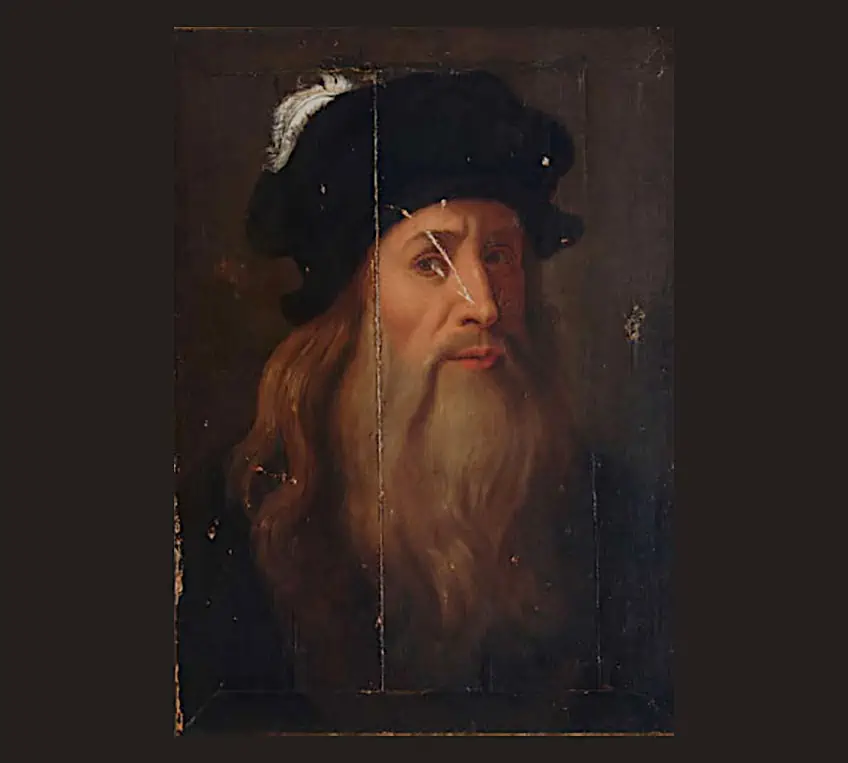
He was responsible for the early research of several fields of study, including civil engineering, anatomy, optics, geology, and hydrodynamics, yet never published his findings. Unfortunately, many of his ideas could not be realized in his own lifetime as many of the technologies required to manufacture his concepts were still in their infancy, such as engineering and metallurgy. These concepts included a ratio-adding device, solar power mechanisms, armored vehicles, and flying machines comparable in design to helicopters.
Renowned for his works such as The Last Supper (1498), and Salvator Mundi (1510), it is the Mona Lisa painting that is his most revered work. All these works exhibit his remarkable talents, so why is the Mona Lisa so famous?
The Eternal Intrigue of the Mona Lisa Painting
Who is Mona Lisa, the woman in the famous painting? Her face is known to everyone, but who was she and why did Da Vinci choose to paint her portrait? Many believe that the painting was commissioned by Francesco del Giocondo and that it portrays his wife, Lisa del Giocondo. They were just about to have their second child and had moved into a new home, and Francesco del Giocondo had ordered it to be painted so that it could adorn their new abode.
However, Giocondo’s commission was either never completed or remained in Da Vinci’s possession until his death, where it is speculated that the Mona Lisa was the portrait of a woman that became the property of his favorite apprentice Salai.
At some point, it became the property of France’s King Francis I, and subsequently the property of the republic itself. Since 1797 it has been on permanent display at the Louvre Museum in Paris, France.
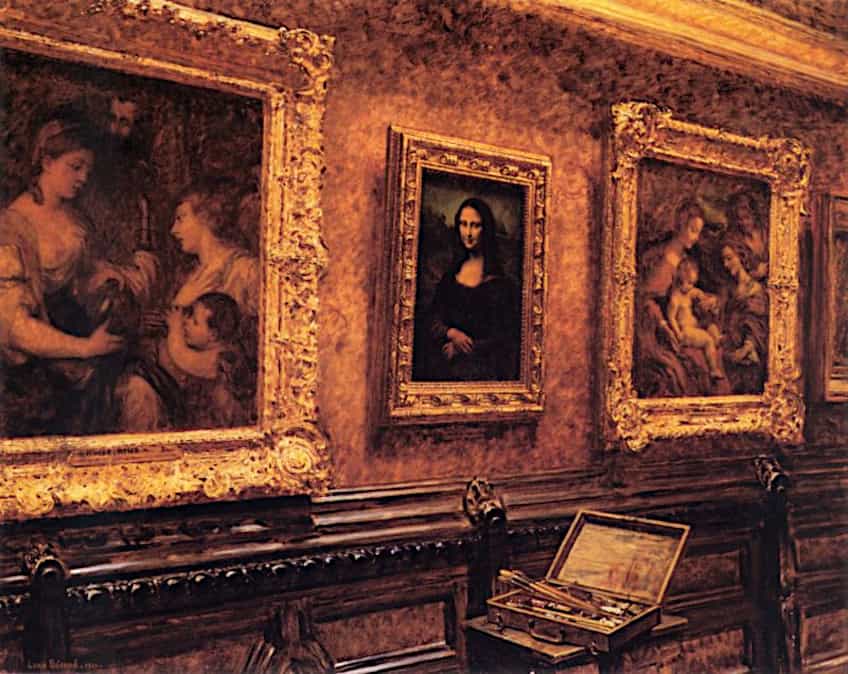
Yet, Lisa del Giocondo is not the only person that has been put forward as the potential subject of the artwork. An alternative individual that has often been proposed is Isabella d’Este. Da Vinci produced a drawing of her in 1499 that bare certain remarkable similarities to the Mona Lisa painting, such as the clothing and position of the hands. It has been pointed out that the background landscape is consistent with that of d’Este’s country of origin, and the placing of her arms on the armrest was often used to symbolize sovereignty.
Letters written by de’Este also reveal that she had made several requests to Da Vinci to complete the painted version of the sketch between 1501 and 1506.
The Louvre Museum has countered that theory by stating that de’Este had blonde hair, however, there is only one such portrait that depicts her with light hair, whereas the rest are comparable to that of the Mona Lisa painting.
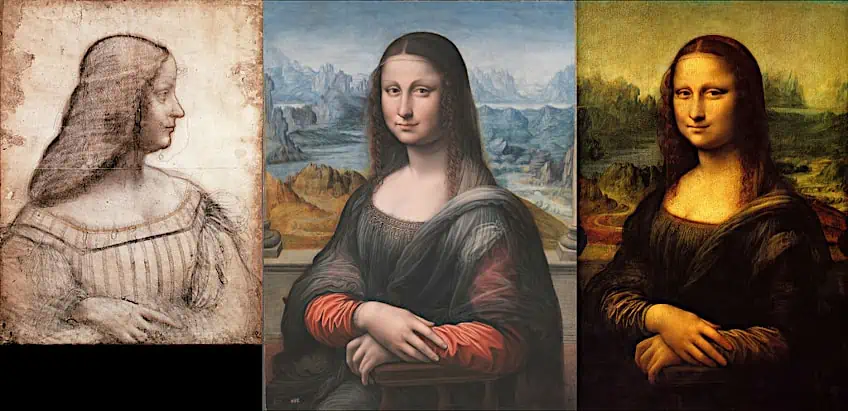
Description of the Mona Lisa by Leonardo da Vinci
The Mona Lisa painting is remarkably similar to numerous Renaissance portraits of the Virgin Mary, who was regarded as a model for womanhood in that period. The subject sits upright, with her arms folded in front of her, and her eyes locked on the viewer. She seems life-like to an exceptional degree, which Da Vinci achieved by avoiding sketching outlines, a method known as sfumato. This subtle blending produces an ambiguous atmosphere, which is especially visible in two aspects of this painting: the corners of her eyes, and the corners of her lips.
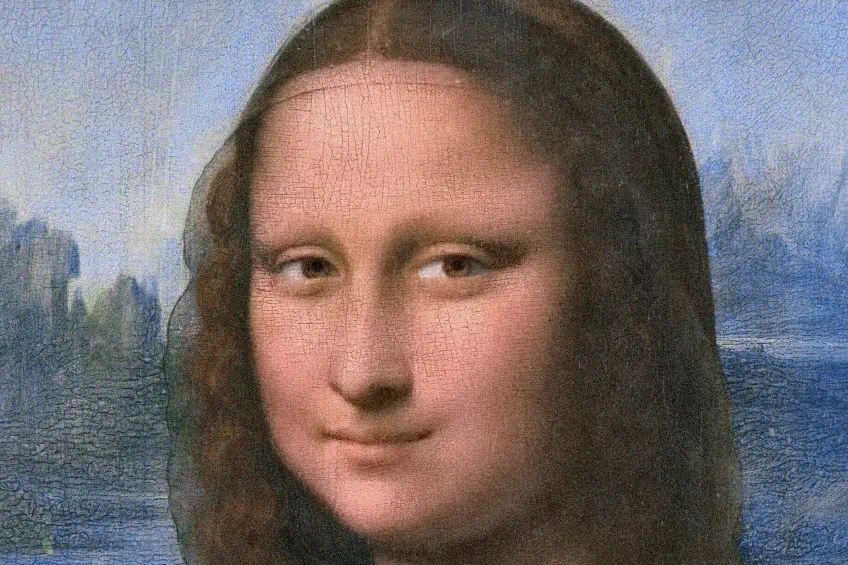
The sitter is depicted in a three-quarter profile, which is reminiscent of paintings by Agnolo di Domenico del Mazziere and Lorenzo di Credi produced in the late 15th century. It was one of the earliest portraits to represent the individual in front of an imagined landscape, and Da Vinci was also a pioneer in the application of aerial perspective. The intriguing figure is depicted seated in an open loggia with black pillar bases on each side. A vast landscape recedes behind her to the snowy mountains in the background. Winding roads and a faraway bridge are the only signs of human life.
The angle at which the landscape is viewed would only have been possible from a very high vantage point, suggesting that Da Vinci has to some degree “invented” it.
Da Vinci decided to position the horizon line on the same level as the eyes, connecting the figure to the environment and accentuating the painting’s enigmatic quality. Although Vasari the historian had described the eyebrows in detail, Mona Lisa lacks easily discernible eyebrows and eyelashes today. Ultra-high-quality scans of the artwork revealed in 2007 that it was initially painted with eyebrows and lashes, but that they had faded over time, possibly due to overcleaning.
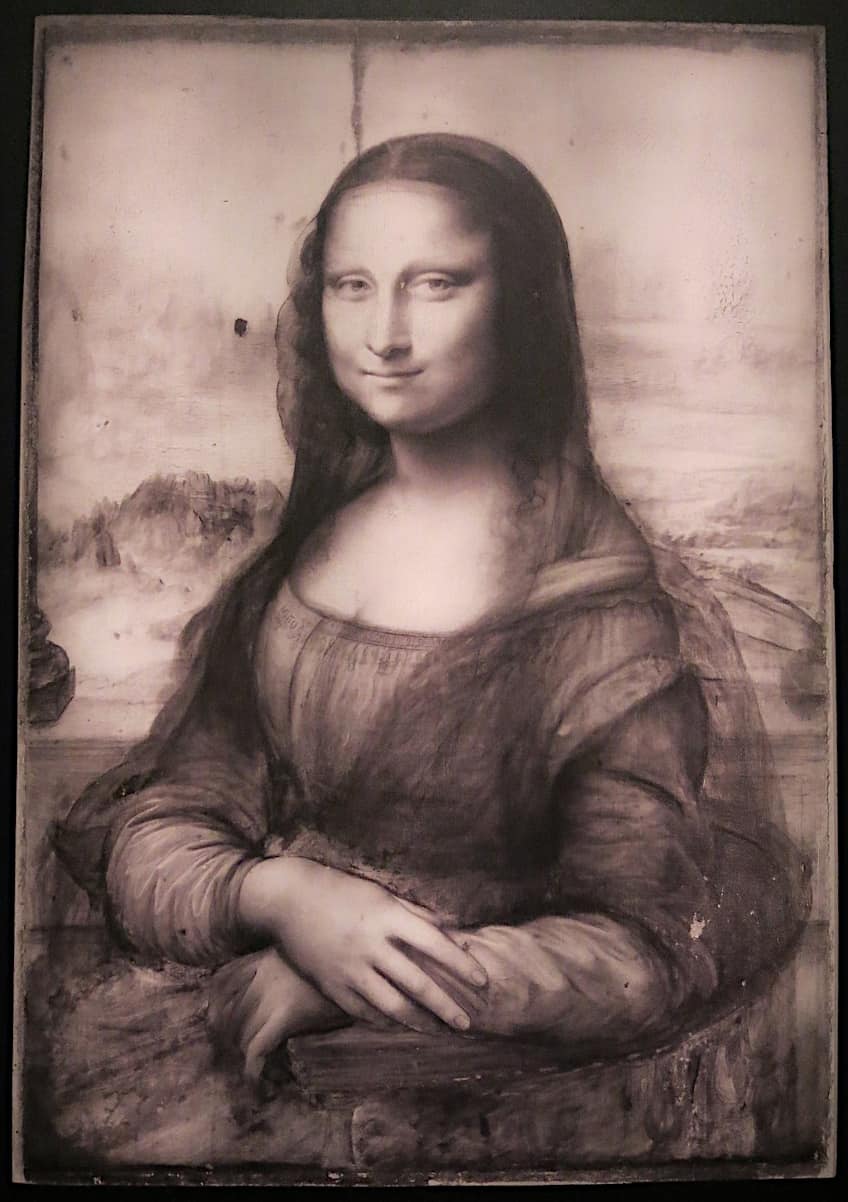
They also determined that the artwork had been altered multiple times, with modifications made to the size and orientation of the Mona Lisa’s head. They also discovered that she was wearing multiple hairpins and a pearl-encrusted headpiece in one layer, which had subsequently been washed away and overpainted. Da Vinci most likely painted his model true-to-life because her appearance is not considered to be the most attractive, not even by late 15th century or even 21st century standards.
When observed directly, her smile seems to vanish. The human eye is less adapted to picking up shadows directly due to the way it processes visual information; yet peripheral vision may pick up shadows well, which is why the smile becomes visible when not viewed from straight ahead.
According to one legend, Da Vinci elicited the smile from his sitter’s lips by hiring musicians and poets to entertain her while he captured her likeness. Ironically, the idea that this portrait possess the uniquely enigmatic smile that is now its primary hallmark, did not become widespread until much later in the painting’s history.
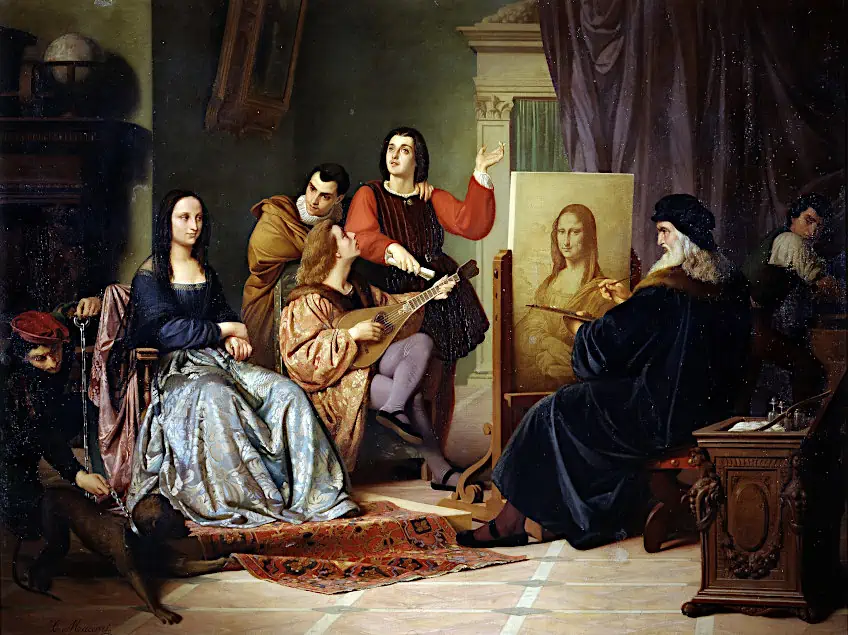
History of the Mona Lisa Painting
The Mona Lisa painting is one of only four works by Leonardo da Vinci whose attribution has not caused debate, and it is the only painting whose provenance has never been significantly questioned. Some people think that it was started in Florence in 1503, however, art historians claim that it is impossible to determine the dates with confidence. Some feel the picture is representative of his style in the years following 1513.
Vasari claims that after four years of working on it, he discontinued any further progress.
In 1516, he was summoned to work at the Clos Lucé by King Francis I; it is thought that he brought the painting with him and kept working on it after moving to France, where according to legend, Da Vinci died in the king’s arms.
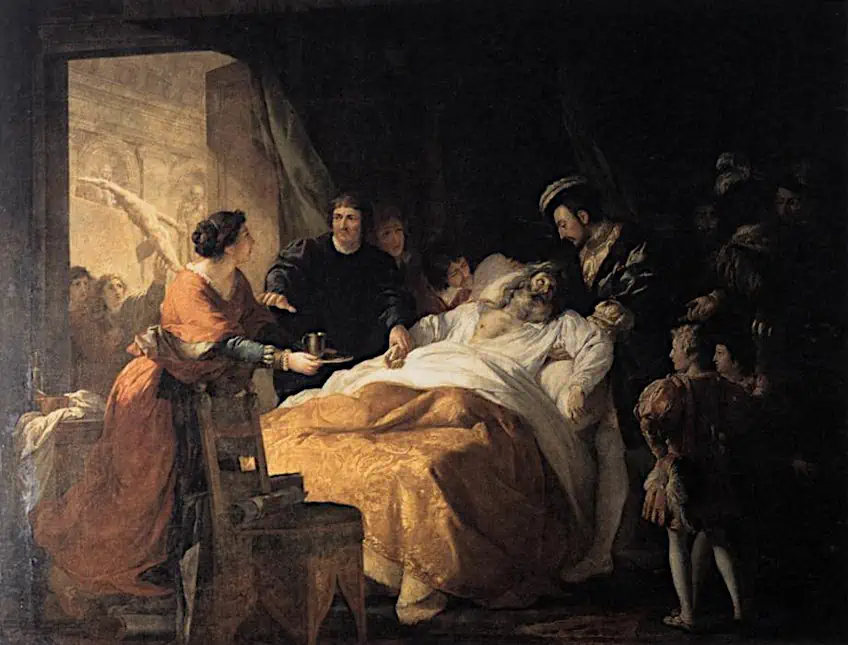
Raphael created a sketch of the painting around 1505, in which the columns bordering the scene are more visible. Experts are united in their opinion that it is based on Da Vinci’s painting. Large flanking columns can also be seen in other subsequent sketches and copies of the painting, such as the Isleworth Mona Lisa, created by various artists through the years. As a result, the Mona Lisa painting was assumed to have been trimmed at some point. However, further analysis of the painting has revealed that it has never been trimmed, meaning that the sketches were possibly modeled after another of Da Vinci’s paintings of similar subject matter.
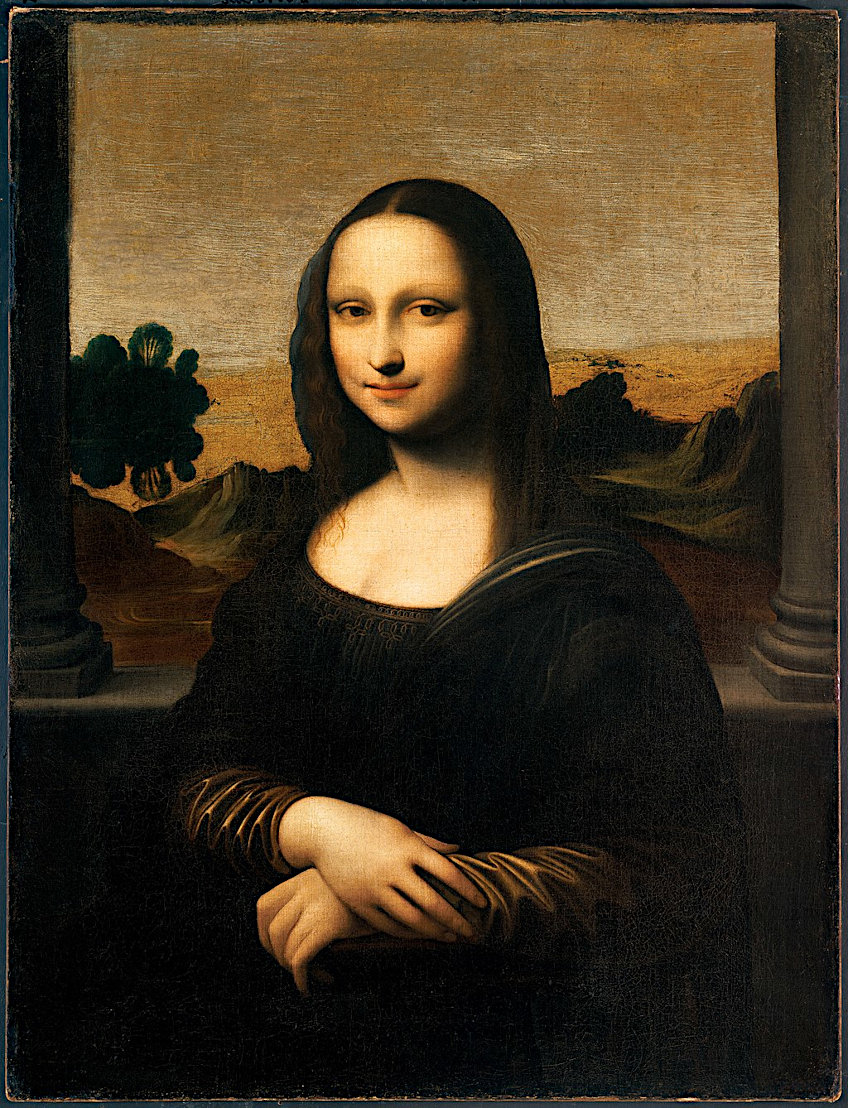
Many historians had asserted that due to the various date discrepancies, and details visible in the sketches that other artists made upon viewing the artwork, there were potentially two versions of the artwork. The hypothetical initial painting, with large columns, would have been requested by Giocondo in 1503 and would have remained incomplete in the possession of Da Vinci’s pupil and aide Sala until his death in 1524. The other, ordered by Giuliano de’ Medici about 1513, was sold by Salai to King Francis I in 1518 and is now housed in the Louvre Museum in Paris, according to this theory.
Besides the two supposed versions created by Da Vinci himself, there are also numerous copies, one of which was created by Da Vinci’s workshop at the same time as the original and is therefore regarded as the most significant of the copies of the Mona Lisa painting.
Before its restoration, it was thought to have been created in the 16th century by an artist whose name has been lost to time. At the time the background had been painted black, veiling the landscape underneath. Today, it has been restored to its former glory and is known as Prado’s Mona Lisa, because it is now housed in the Museo del Prado in Madrid, Spain. Details revealed through the restoration of this version have helped to shed light on the production of the original as well.
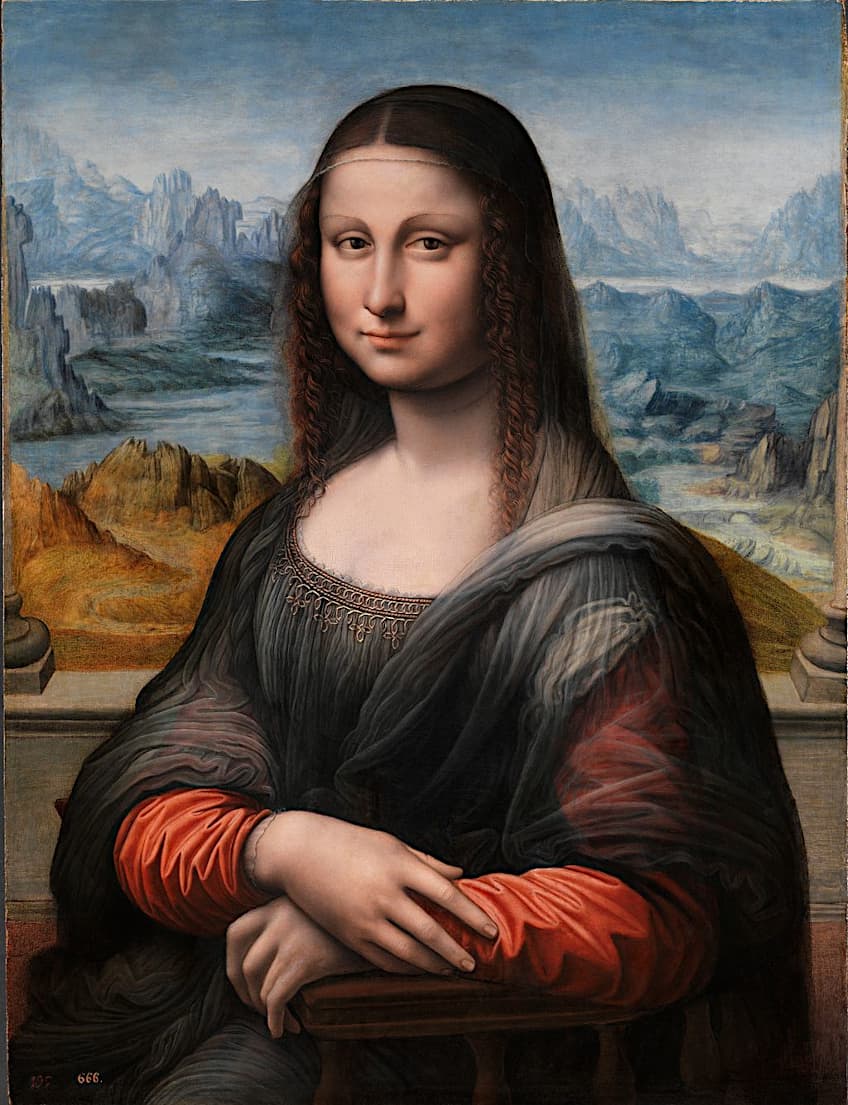
Incidences of Vandalism and Theft of the Mona Lisa Painting
The artwork was transported to the Louvre after the French Revolution, but it was first kept in Napoleon’s bedroom at the Tuileries Palace. Outside of the art world, it was barely acknowledged, but in the 1860s, a few French intellectuals started to laud it as a masterpiece of Renaissance art. The artwork was relocated from the Louvre Museum to the Brest Arsenal, a complex of military and naval facilities located on the banks of the Penfeld River, during the Franco-Prussian War.
The artwork was still largely unknown by the general public in 1911 when it was stolen from the Louvre on the 21st of August 1911. After considerable speculation about whether it was being photographed somewhere, the museum was shut for a week to conduct an investigation.
Guillaume Apollinaire, a French poet, was detained and imprisoned after raising suspicions. He then accused Pablo Picasso, who was questioned, but both were subsequently cleared of any charges.
Vincenzo Peruggia, a museum employee who helped in the construction of the artwork’s glass case, turned out to be the true culprit. He committed the crime by entering the structure during business hours, waiting in a broom cupboard, and leaving with the artwork tucked under his overcoat after it had closed. Peruggia was an Italian who claimed he wanted the artwork to return to its country of origin. His story about simply wanting to do something patriotic may have simply been a cover though, as he did not seem to have any intention of donating it to a museum in Italy.
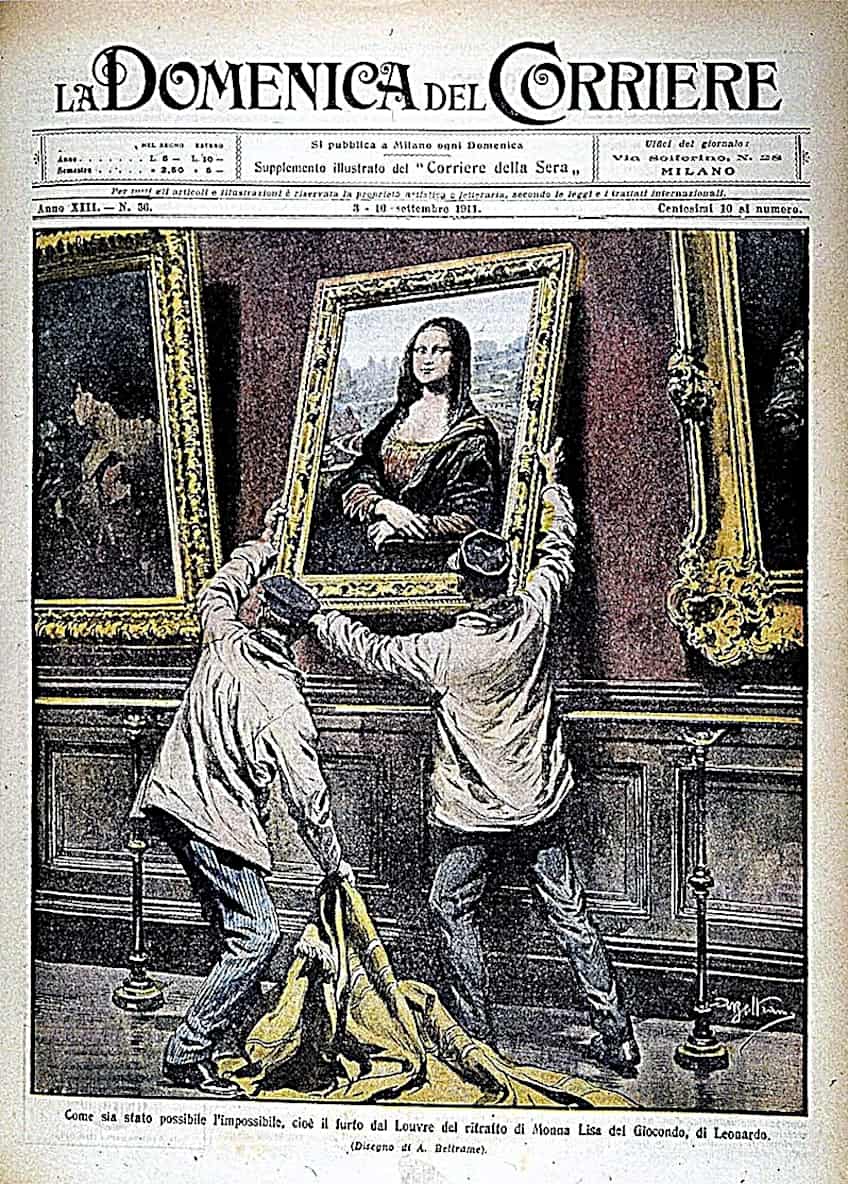
Peruggia became impatient after keeping the painting in his flat for two years and was arrested when he tried to sell it to the director of the Uffizi Gallery. It was put on display in the Uffizi Gallery for about two weeks before returning to the Louvre Museum on the 4th of January 1914.
Peruggia received six months behind bars for the act yet was praised throughout Italy for his patriotism. A year after the incident, an apparent accomplice called Eduardo de Valfierno confessed to having masterminded it.
Yves Chaudron, a forger, was supposed to have made six duplicates of the artwork to try and sell in the United States as the original while hiding it in an undisclosed location. Bolivian Ugo Ungaza Villegas threw a rock at the painting while it was on exhibit at the Louvre on the 30th of December 1956. He cracked the glass case and a bit of pigment on the painting was dislodged. It was luckily protected by glass because an individual who professed to be in love with the artwork had sliced it with a razor blade and attempted to steal it a few years before. Bulletproof glass has now been fitted to protect the artwork from additional assaults.
Following that, on the 21st of April 1974, while the artwork was on exhibition at the Tokyo National Museum, a lady splattered it with red paint in protest of the museum’s inability to provide handicapped individuals with adequate access routes.
Modern Analysis of the Mona Lisa by Leonardo da Vinci
Pascal Cotte, a French physicist, hypothesized a secret portrait hidden beneath the surface of the artwork in the early 21st century. Starting in 2004, he used reflecting light technology to examine the artwork in the Louvre, producing circumstantial support for his hypothesis.
Cotte acknowledges that his research was conducted just to support his theories and should not be viewed as irrefutable evidence.
The underlying portrait appears to be of a model gazing to the side and is devoid of surrounding columns, however, does not correspond to the historical description of the artwork. Unlike the figure in Cotte’s claimed portrait, both Gian Paolo Lomazzo and Vasari described the subject as smiling. Cotte presented research in 2020 claiming that the artwork has an underdrawing transferred from a preliminary sketch.
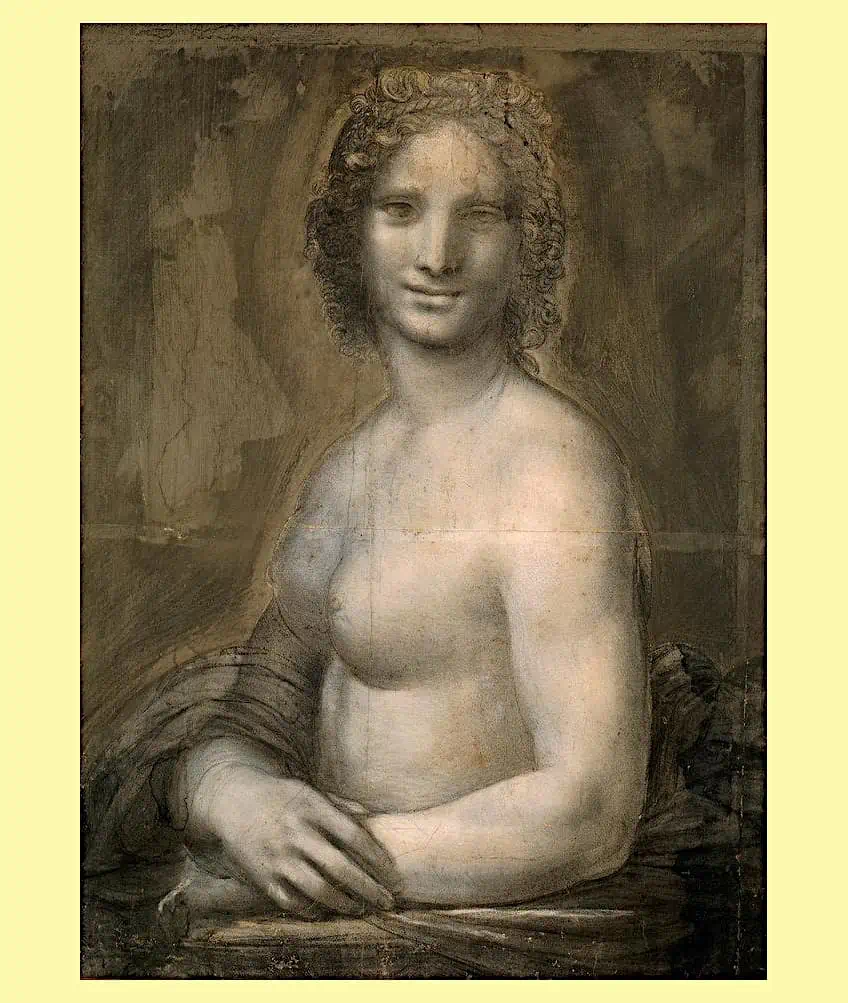
How Much Is the Mona Lisa Worth Today?
Prior to the 1963 tour, the artwork was insured for $100 million, which equates to $700 million in 2023, making it the most valuable painting in the world. Instead of purchasing insurance, more money was spent on security. The Mona Lisa is now exhibited behind layers of bulletproof glass under permanent guard in the Louvre Museum.
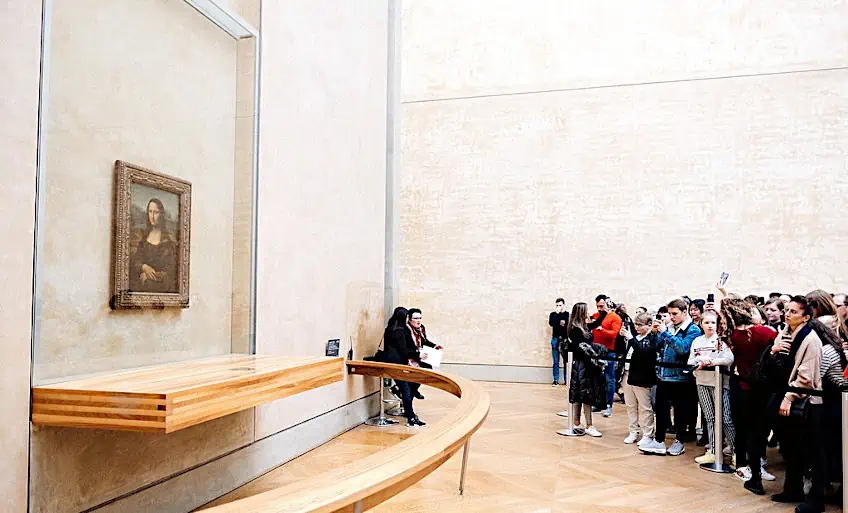
In 2014, an article suggested that the portrait could be auctioned to help reduce the national debt. However, The Mona Lisa and other similar artworks were stated to be prohibited from being auctioned by French law, which specifies that artifacts held in collections that belong to public institutions are legally regarded as public property.
All these facts about the Mona Lisa have made us want to buy a ticket and go see it for ourselves! The Mona Lisa by Leonardo da Vinci truly is a masterpiece produced by a legitimate master – a genuine Renaissance man. Although not really even acknowledged by the public at large until it was stolen, today it is arguably the most well-known painting ever produced. No other artwork has been replicated, reproduced, and parodied more through the centuries. It has also been the subject of continuous attacks and abuse, with people trying to slice it, pour substances over it, and just outright steal it. For the rest of the world, though, it has been constantly reinforced with security measures so that we may enjoy it for years to come.
Take a look at our Mona Lisa painting webstory here!
Frequently Asked Questions
Where Is the Mona Lisa Painting Located Currently?
Today, the famous artwork is housed at the Louvre Museum in Paris, France – its permanent residence except for the rare tour. Before being put in the museum, it had been kept in several other interesting locations. It once even hung on the bedroom wall of Napoleon!
When Was the Mona Lisa Painted?
There has been so much debate over the exact date that it was started and completed, that some people even believe that there were two versions of the painting, hoping to explain the discrepancies in varying accounts. Most people generally agree that it was started sometime between the years 1503 and 1506. As for when it was completed, there are varying dates that have been put forward, with most suggesting a timeframe of around 1516. Another painting of the same subject titled Prado’s Mona Lisa (c. 1503 – 1516) – created by the workshop of Da Vinci – was produced simultaneously with the original. Despite being largely ignored as a later copy, it was subsequently recognized as belonging to the artist’s own workshop and hailed for its own beauty and execution. Today, it is exhibited in Museo del Prado in Spain.
Jordan Anthony is a Cape Town-based film photographer, curator, and arts writer. She holds a Bachelor of Art in Fine Arts from the University of the Witwatersrand, Johannesburg, where she explored themes like healing, identity, dreams, and intuitive creation in her Contemporary art practice. Jordan has collaborated with various local art institutions, including the KZNSA Gallery in Durban, the Turbine Art Fair, and the Wits Art Museum. Her photography focuses on abstract color manipulations, portraiture, candid shots, and urban landscapes. She’s intrigued by philosophy, memory, and esotericism, drawing inspiration from Surrealism, Fluxus, and ancient civilizations, as well as childhood influences and found objects. Jordan is working for artfilemagazine since 2022 and writes blog posts about art history and photography.
Learn more about Jordan Anthony and about us.
Cite this Article
Jordan, Anthony, ““Mona Lisa” by Leonardo da Vinci – Get to Know La Giaconda.” artfilemagazine – Your Online Art Source. September 13, 2023. URL: https://artfilemagazine.com/mona-lisa-by-leonardo-da-vinci/
Anthony, J. (2023, 13 September). “Mona Lisa” by Leonardo da Vinci – Get to Know La Giaconda. artfilemagazine – Your Online Art Source. https://artfilemagazine.com/mona-lisa-by-leonardo-da-vinci/
Anthony, Jordan. ““Mona Lisa” by Leonardo da Vinci – Get to Know La Giaconda.” artfilemagazine – Your Online Art Source, September 13, 2023. https://artfilemagazine.com/mona-lisa-by-leonardo-da-vinci/.


